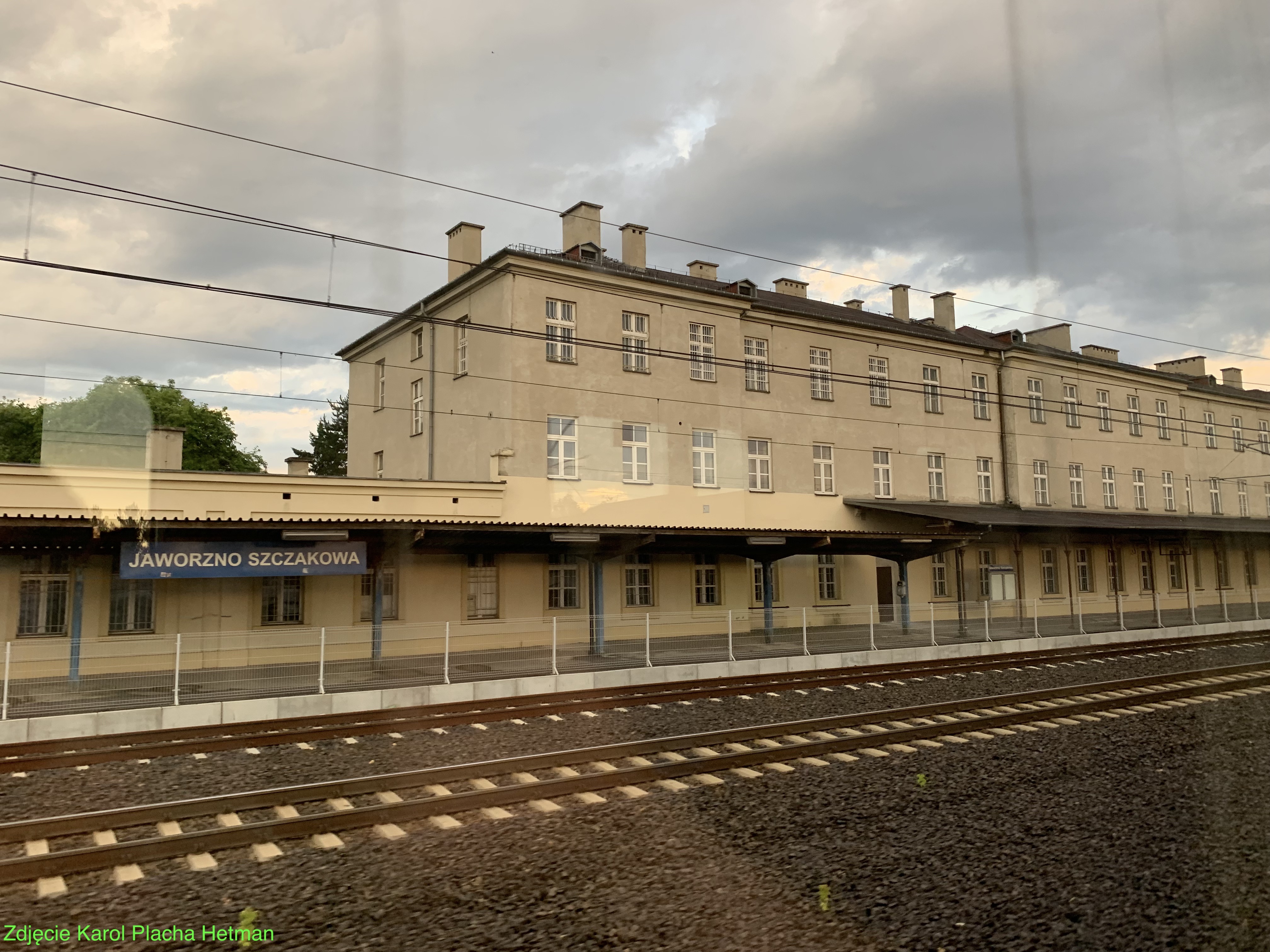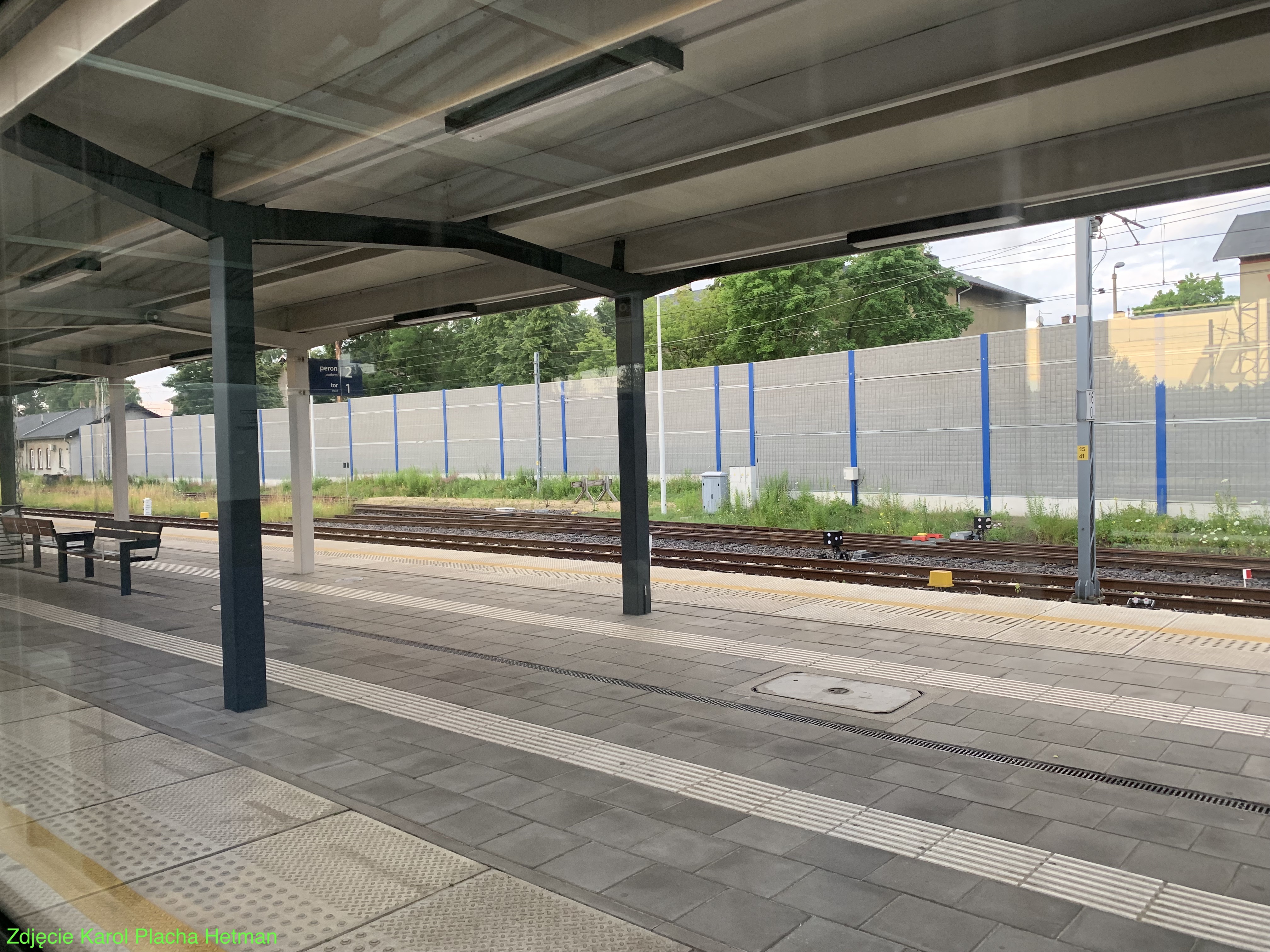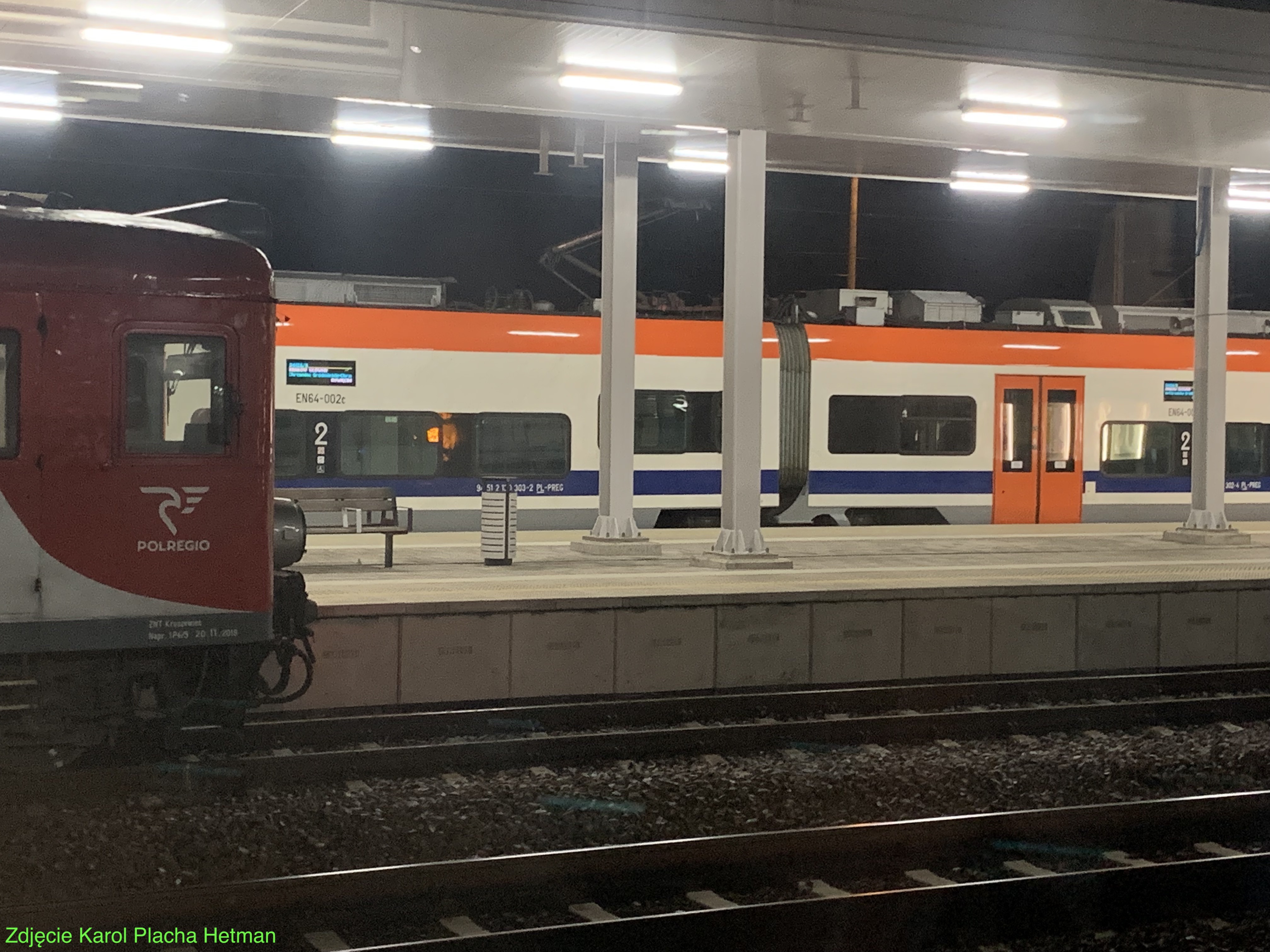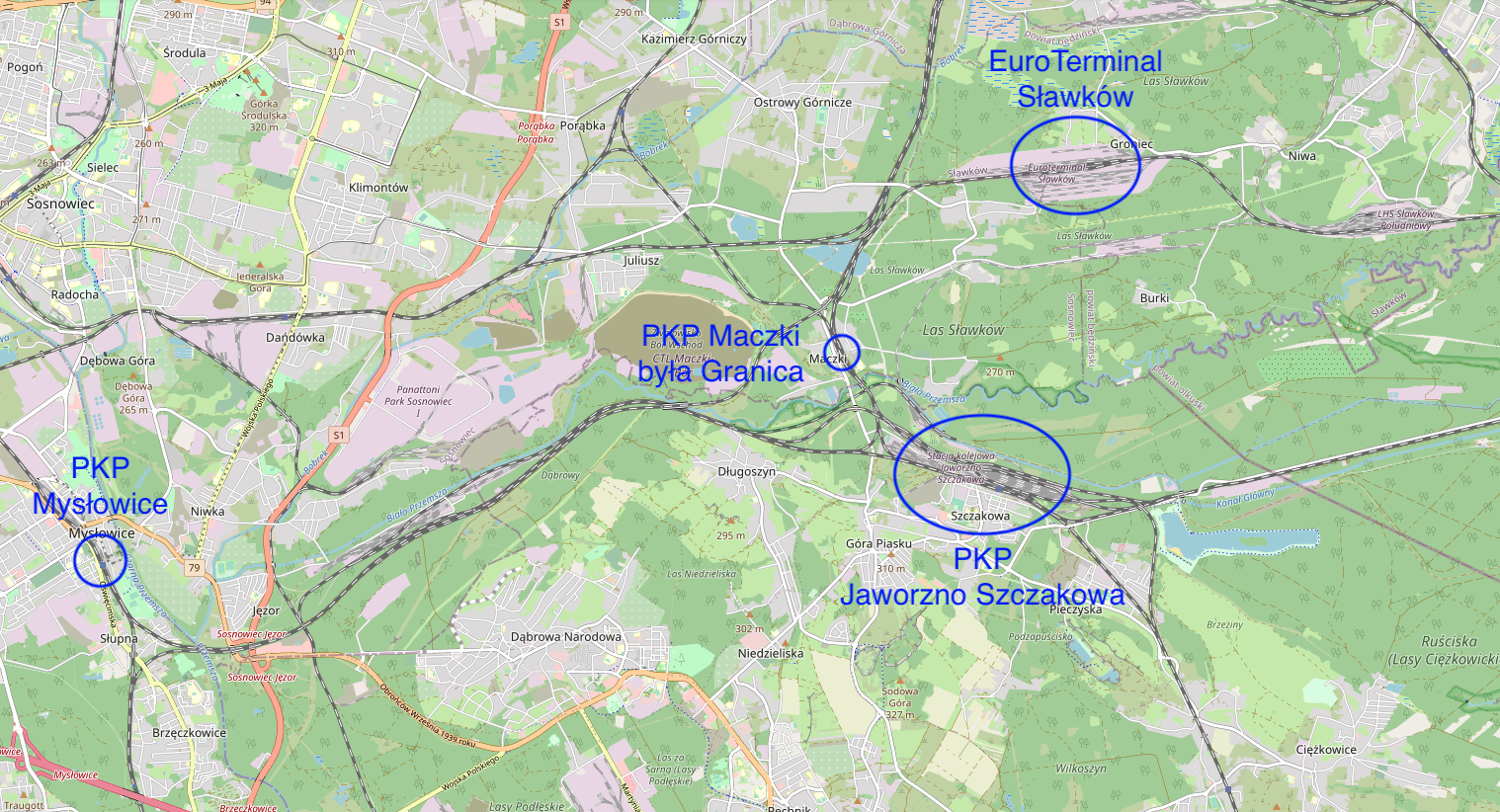Jaworzno 2023-02-17
Jaworzno Szczakowa railway station.
Geographic coordinates: 50.246N 19.295E.





City of Jaworzno.
Jaworzno is a city in Poland, located in the south of the country, in the Upper Silesian Voivodeship. In the period 1945 - 1975, Jaworzno belonged to the province of Krakow. In the period 1975–1998, Jaworzno was within the boundaries of the Katowice Voivodeship. The settlement was founded before 1229. City rights were granted in 1901. Currently, the area of the city is 151.6 square kilometers. The city has undulating terrain, ranging from 230 m above sea level to 354 m above sea level. The population of the city is 88,267 inhabitants (2021).
The town took its name from the Slavic name of the sycamore tree (Acer pseudoplatanus), which grows in the town. Historical legend says: In 1330, the future king Casimir III the Great was returning from Poznań to Kraków at the call of his father Władysław Łokietek. In the area now called Lord's Mountain, he encountered lumberjacks cutting sycamore trees and asked them what they were doing. Then one of them replied: "We se sycamore znolotyk, what a śrybra bitch" (which can be translated: We cut sycamore for those who are looking for silver). On the basis of this story, the current coat of arms of the city was created - a spreading sycamore tree and two lumberjacks cutting it down. The name of the village in the Polish form of Jaworzno is mentioned in the period (1470 - 1480) by Jan Długosz in the book Liber beneficiorum dioecesis Cracoviensis. Jan Długosz also mentions the present district of the city of Szczakowa in the form of Sczaków, as a separate town that was attached to Jaworzno after World War II.
Geographically, Jaworzno is located in the Kraków-Częstochowa Upland. In terms of culture and history, Jaworzno belongs to the Krakow Land. These are indigenous Polish lands. In the period 1815 - 1846, Jaworzno (similarly to Krzeszowice and Trzebinia) was part of the Republic of Krakow, despite the ongoing annexations of the Polish Lands by the Prussians, Muscovites and Austrians. However, in 1846, these lands were annexed by Austria into the borders of Galicia.
In the vicinity of Jaworzno there is a junction of the following rivers: Przemsza and its tributary Biała Przemsza.
Initially, silver and lead from galena were mined near Jaworzno, then zinc and iron ore. In 1767, the first Polish hard coal mine was established in Szczakowa, and "black gold" has been mined in the area since then.
Angle of the Three Emperors.
Angle of the Three Emperors, or rather three imperial countries with barbaric tendencies towards other nations: Prussia (Germany), Austria (later Austro-Hungary) and Muscovites (Russia). This term functioned in the period 1846 - 1915, but in Polish it was called "Emperor's Privy".
The first important border changes in this area appeared in 1742, when as a result of the Austro-Prussian war, a large part of Silesia passed from Austria to Prussia. At that time, the Czarna Przemsza River became the border separating Prussia from the Duchy of Siewierski, which was a Polish fief. From 1790, after the Duchy of Siewierski was merged with Polish lands, it was the border with the Republic of Poland. This state of affairs changed during the 3rd partition of Poland, where the entire area was included in Prussia, and the borders of the three imperial powers in the period 1795 - 1807, i.e. from the 3rd partition of Poland to the creation of the Duchy of Warsaw, converged in the area of the town of Niemirów to shape in Czarna Przemsza in 1807, as a result of the Treaty of Tylża. In the period 1815 - 1831, after the Congress of Vienna (Dancing Congress), the borders of the Congress Kingdom, Prussia and the Republic of Krakow converged there. In the period 1831–1846, after the incorporation of the Kingdom of Poland into the Muscovite state as an autonomous province, it was the meeting point of the borders of the Muscovite state (Russia), the Germans (Prussia) and the Republic of Kraków. Then, after the latter was incorporated into the Austrian Empire, in the period 1846 - 1871, the borders between the Kingdom of Prussia, the Austrian Empire (from 1867, Austria-Hungary) and the Muscovite Empire converged there.
The name Triangle (Angle) of the Three Emperors was created after 1871, when the Germans were unified and this place, still remaining on the border of the Kingdom of Prussia, also became a border point of the German Empire. Border lines ran along the rivers: Biała Przemsza, Czarna Przemsza and Przemsza.
The border ceased to exist in this place in 1915, when the imperial states took their heads and led to the outbreak of the Great World War, and the "Prison of the Three Emperors" ceased to exist. The whole area re-entered the borders of the Republic of Poland.
The development of the city of Jaworzno.
In the 19th century, industrial development contributed to the development of Jaworzno. A major influence on the economic development was the construction of the railway line of the Association of the Krakow-Górnośląska Railway in 1847 through Szczakowa. From April 30, 1850, the trail was under the management of "C.K. Emperor Ferdinand's Privileged Northern Railway.
At the same time (1848) to the Granica station, now Sosnowiec Mączki, the Warsaw-Vienna Railway line from Warsaw was brought. The railway stations: Szczakowa, Mysłowice and Granica became places of transshipment of goods between the three imperialists.
In 1898, the first hard coal-fired power plant was built in Jaworzno. Hard coal mining accounted for 84% of mining in all of Galicia. More factories were built in the area: the Zinc White Factory, the Soda Ammonia Factory (transformed into the "Szczakowa" Window Glassworks), a tannery, a sawmill, a brickyard, and the "Azot" Nitrogen Works (1916). On September 21, 1901, the occupier, Emperor Franz Joseph I, signed the act of the Lviv Seym on granting town rights to Jaworzno.
The Germans showed their cruelty towards the Polish nation during the Second World War by organizing forced labor camps and concentration camps, the largest of which was KL Auschwitz-Birkenau. After World War II, the communists took over Germanic and Soviet patterns. In April 1945, the so-called Central Labor Camp was established in Jaworzno. Among others, Home Army soldiers, Germans, as well as Ukrainians and Lemkos suspected of collaborating or sympathizing with the OUN and UPA were imprisoned here. The camp existed until February 1949, transforming into the so-called Progressive Prison for Juvenile Offenders, modeled on Soviet gulags. The center in Jaworzno was officially closed in 1956, after the prisoners' revolt, which took place on May 15, 1955. In 1990, the Union of Juvenile Political Prisoners "Jaworzniacy" was established.
After World War II, many Poles came to Jaworzno and other nearby towns in search of work in the industry. Workplaces, and especially mines, built new housing estates for their employees and their families. Huge power stations were built, which were given successive names; Jaworzno I Power Plant, Jaworzno II Power Plant, Jaworzno III Power Plant. Currently (2023), bureaucrats from the European Union are striving to liquidate Polska Energetyka and Polskie Górnictwo. Currently, there is only one mine in the city, ZG Sobieski, owned by Tauron Wydobycie. Formerly, there was also the Jan Kanty Mine. We had 57 hard coal mines in the Republic of Poland. Currently (2023) we have only 17 mines.
Road communication.
Jaworzno is located at the crossroads of a number of road communication routes. The following roads run through the city: A4 motorway (part of the European route E40) connecting the state borders (east - west) Jędrzychowice - Korczowa. Expressway S1 (part of the European route E75) Gdańsk - Zwardoń. National road No. 79 Warsaw - Bytom. Provincial road No. 903 Jaworzno 79 - Jaworzno A4.
Railway transport.
The Jaworzno Szczakowa railway station is one of the largest railway junctions in Poland and an important passenger traffic point. Rail freight transport is primarily the transport of hard coal, steel products, and goods in containers. The Jaworzno Szczakowa station is at the junction with the so-called sand railway, which is independent of PKP. Due to the location of the city, transit transport, also international, plays an important role. The Jaworzno Szczakowa railway station plays the same role as the station; Myslowice, Trzebinia, Krzeszowice.
The following railway stations and stops are and have been in the city; Jaworzno Szczakowa - the most important station in the city. Jaworzno Ciezkowice. Jaworzno Szczakowa Locomotive depot. Jaworzno Niedzielska - does not exist. Jaworzno - does not exist. Jaworzno Azot - does not exist. Jaworzno Shaft Sobieski - does not exist. Bory - does not exist. Jaworzno Byczyna - does not exist. Forest - does not exist.
The Jaworzno Szczakowa railway station is located in the northern part of the city in the Szczakowa district. There are three platforms at the station. Platform 1 has a single edge and is located at the station. The platform has been decommissioned. Platform 2 has two edges. Platform 3 is also double-edged. The last renovation of the station was carried out in the period 2017 - 2021.
The station has a double-track marshalling hill with about 30 directional tracks. There is an active locomotive depot at the station, in which the PKP Operations Plant and PKP Energetyka SA Górnośląski Plant operate. Railway traffic is controlled from four signal boxes: JSB, JSE, JSC, JSR. There is a disused water tower in the station area. At the station there is the office of the Polish Post Office, the Railway Protection Guard Station, the "Kultowa Canteen" restaurant, the "Kolor kod" hostel, and several grocery stores.
On the northern side of the Jaworzno Szczakowa station there is Kolej Piaskowa, which does not belong to PKP. A little further north is the EuroTerminal Sławków, where the LHS broad-gauge line begins (Linia Hutnicza Szerokotorowa, previously the Metallurgical and Sulfur Line).
Passenger traffic.
In 2021, the station served over 600 passengers a day. Currently (February 2023) 78 trains depart from Jaworzno Szczakowa station daily to: Bohumín - 3 TLK "Galicja", "Roztocze" and InterCity "Chopin" trains. Dębica - 2 PolRegio trains. Gdynia Główna - 3 InterCity trains "Artus", "Piast", TLK "Rozewia". Jelenia Gora - TLK "Sudety". Katowice - 18 PolRegio and Koleje Śląskie trains. Kraków Główny - 30 PolRegio trains, Koleje Śląskie, InterCity, TLK. Lublin Main - TLK Roztocze. Olkusz - 6 PolRegio trains. Poznań Główny - 3 trains TLK Pułaski, InterCity "Wybicki", "Ślązak". Przemyśl Główny - 5 InterCity trains. Szczecin - 2 InterCity trains. Świnoujście - 2 InterCity trains. Ustka - InterCity "Przemyślin". Warsaw - InterCity "Chopin". Wroclaw - InterCity "Grottger".
Railway lines:
Railway line No. 126 Chrzanów – Płaza is a railway line with a length of 6.537 km, of local and freight importance. Formerly, the line connected Jaworzno Szczakowa - Bolęcin. The line is not electrified. The line opened in 1900. The line opened in 1900. In 1981, the running of trains on the Jaworzno Szczakowa - Bolęcin section was suspended. The tracks were dismantled on the section Jaworzno - Chrzanów. In connection with the above, a new kilometer of the line was introduced, which now starts at the Chrzanów station and ends near the cargo hold at the former Płaza station. In 1991, the section Chrzanów - Bolęcin was electrified, and in 1995, train traffic was suspended with the simultaneous dismantling of the traction network. Currently (2023), the section Chrzanów - Płaza is renovated and passable.
Railway line No. 133 Dąbrowa Górnicza Ząbkowice – Kraków Główny. The line is double-track, electrified, with a length of 70.779 km. The maximum speed is 160 km/h. The line runs through the Śląskie and Małopolskie voivodships. The section Jaworzno Szczakowa - Kraków Główny is part of the international E 30 railway line. The renovation of the route was planned to be carried out in the period 2010 - 2014. Due to the significant extension of the scope of renovation, the basic works were completed in 2020.
Railway line No. 134 Jaworzno Szczakowa - Mysłowice and further to Katowice, it is a double-track, electrified line with a length of 11.991 km. The lines started in 1847. Electrification took place in 1959. The line is part of the international E 30 railway line. The maximum speed is 160 km/h.
Railway line No. 156 Jaworzno Szczakowa - Bukowno and further to Olkusz, it is a double-track, electrified line with a length of 11.737 km. The maximum speed is 120 km/h. The line was built in the period 1935 - 1939 and opened in 1939, and electrification was done in 1966.
Railway line No. 666 Sosnowiec Maczki - Jaworzno Szczakowa JSC is a slip road that was built in 1942. The length of the slipway is 1,950 m. In 1959, the slipways were electrified.
Railway line No. 668 Jaworzno Szczakowa JSB - Długoszyn is a slip road that was built in 1942. The length of the slipway is 1,880 m. In 1959, the slipways were electrified.
Railway line No. 669 Jaworzno Szczakowa - Pieczyska T4P is a connecting link from the freight part of the station (eastern head) towards Krakow.
Railway line No. 670 Jaworzno Szczakowa T4B - Borowa Górka is a connector in the direction of Olkusz.
Railway line No. 715 Jaworzno Szczakowa R105 - Borowa Górka is a slip road in the freight part of the station in the direction of Olkusz.
Written by Karol Placha Hetman
